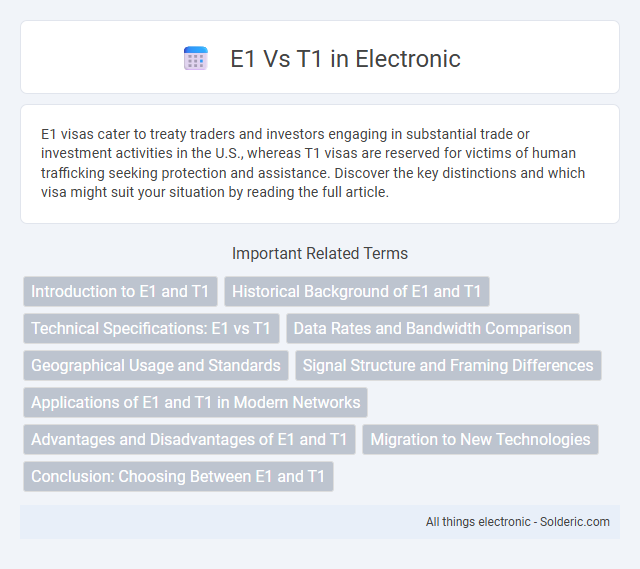E1 visas cater to treaty traders and investors engaging in substantial trade or investment activities in the U.S., whereas T1 visas are reserved for victims of human trafficking seeking protection and assistance. Discover the key distinctions and which visa might suit your situation by reading the full article.
Comparison Table
| Feature | E1 | T1 |
|---|---|---|
| Region | Europe | North America |
| Line Speed | 2.048 Mbps | 1.544 Mbps |
| Channels | 32 channels (30 voice + 2 signaling) | 24 channels (23 voice + 1 signaling) |
| Framing | 32 time slots per frame | 24 time slots per frame |
| Symbol Rate | 8,000 symbols/second | 8,000 symbols/second |
| Signal Type | PCM (Pulse Code Modulation) | PCM (Pulse Code Modulation) |
| Use Case | Telephony and data in Europe | Telephony and data in North America |
| Standard | ITU-T G.703, G.704 | ANSI T1.403 |
Introduction to E1 and T1
E1 and T1 are digital transmission systems commonly used in telecommunications to carry multiple voice and data channels over a single physical line. E1, primarily used in Europe, supports 32 channels at 2.048 Mbps, while T1, predominant in North America, provides 24 channels at 1.544 Mbps. Your choice between the two depends on regional standards and bandwidth requirements for efficient communication.
Historical Background of E1 and T1
E1 and T1 were developed during the 1960s to address the growing need for high-capacity digital communication channels, with T1 originating in the United States and E1 in Europe. E1 supports 32 channels at 2.048 Mbps, while T1 provides 24 channels at 1.544 Mbps, each tailored to regional telecommunication standards. Understanding this historical background helps you appreciate why network infrastructures differ across continents and informs decisions in selecting appropriate digital transmission systems.
Technical Specifications: E1 vs T1
E1 and T1 are digital transmission formats used in telecommunications with distinct technical specifications: E1 operates at a data rate of 2.048 Mbps across 32 channels, each channel transmitting 64 Kbps, while T1 functions at 1.544 Mbps with 24 channels also carrying 64 Kbps each. E1's framing structure includes 31 data channels and one signaling channel, whereas T1 includes 24 data channels without a dedicated signaling channel but uses out-of-band signaling. Understanding these technical differences helps optimize Your network infrastructure depending on regional standards and bandwidth requirements.
Data Rates and Bandwidth Comparison
E1 offers a data rate of 2.048 Mbps with a bandwidth allocation of 2.048 MHz, commonly used in Europe and Asia for digital transmission. T1 supports a slightly lower data rate of 1.544 Mbps and occupies a bandwidth of 1.544 MHz, primarily deployed in North America and Japan. Your choice between E1 and T1 directly impacts network capacity and compatibility depending on regional telecommunication standards.
Geographical Usage and Standards
E1 is predominantly used in Europe, Asia, and other regions following the ITU-T G.703 standard, providing 2.048 Mbps over 32 channels, while T1 is mainly deployed in North America and Japan under the ANSI T1.403 standard, delivering 1.544 Mbps across 24 channels. The differing framing structures and signaling protocols reflect regional telecommunications infrastructure preferences and regulatory environments. Network equipment and service providers must ensure compatibility with local standards to maintain seamless digital transmission and reliable voice and data communication.
Signal Structure and Framing Differences
E1 uses 32 time slots in a 2.048 Mbps frame, with 30 channels for voice/data, one for signaling, and one for framing, employing CRC-based framing for synchronization. T1 transmits 24 channels at 1.544 Mbps, using a Superframe (SF) or Extended Superframe (ESF) structure with specific framing bits for synchronization and signaling embedded in the least significant bit or out-of-band. The key difference lies in E1's use of time slots and CRC multiframe for precise synchronization, whereas T1 relies on framing patterns and bit-stealing for signaling within its lower channel count.
Applications of E1 and T1 in Modern Networks
E1 interfaces, supporting 2.048 Mbps, are widely used in European and Asian telecommunications for voice and data transmission in traditional telephony and private branch exchange (PBX) systems. T1 lines, providing 1.544 Mbps, dominate North American networks, enabling digital signaling for internet connectivity, leased line services, and T-carrier systems within enterprise and service provider environments. Both E1 and T1 are integral to legacy infrastructure while facilitating integration with contemporary IP-based technologies through gateways and session border controllers.
Advantages and Disadvantages of E1 and T1
E1 offers 32 channels at 2.048 Mbps, making it cost-effective with widespread use in Europe and Asia, but it has lower compatibility in North American systems. T1 provides 24 channels at 1.544 Mbps, delivering reliable service with higher compatibility in North America and the United States but typically at a higher cost. E1's advantages include higher channel capacity and lower cost, while T1's strengths lie in better interoperability and robust support in its primary markets.
Migration to New Technologies
Migration from E1 to T1 infrastructure involves shifting from a European digital transmission standard with 2.048 Mbps to a North American standard providing 1.544 Mbps, which impacts network compatibility and bandwidth capacity. Enterprises transitioning to T1 lines benefit from widespread support in the Americas, facilitating integration with modern IP-based systems and enabling scalable data services. Embracing T1 technology accelerates adoption of VoIP, broadband internet, and advanced telecommunication protocols crucial for digital transformation initiatives.
Conclusion: Choosing Between E1 and T1
Choosing between E1 and T1 depends primarily on geographic location and bandwidth needs, as E1 provides 2.048 Mbps mainly in Europe and Asia, while T1 offers 1.544 Mbps predominantly in North America. E1 delivers 32 channels, each with 64 Kbps, versus T1's 24 channels of 64 Kbps, affecting overall capacity and application suitability. Organizations must evaluate network standards, infrastructure compatibility, and required data throughput to make an informed choice between E1 and T1 lines.
E1 vs T1 Infographic

 solderic.com
solderic.com